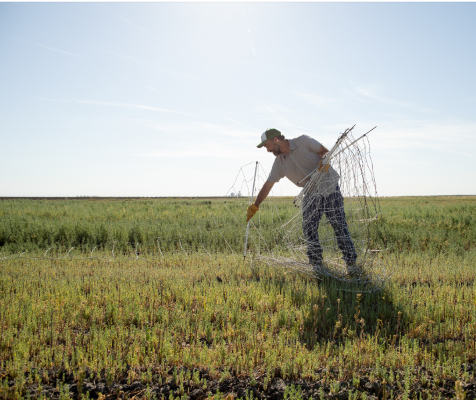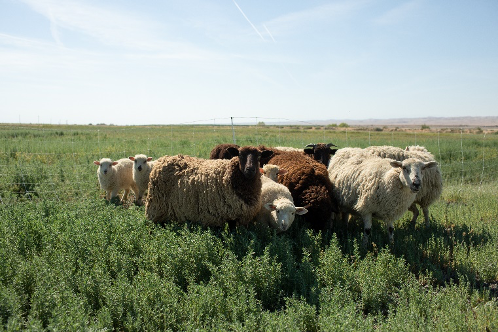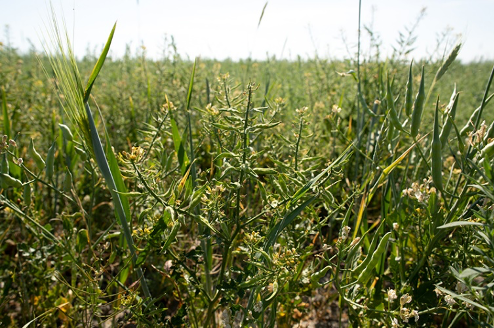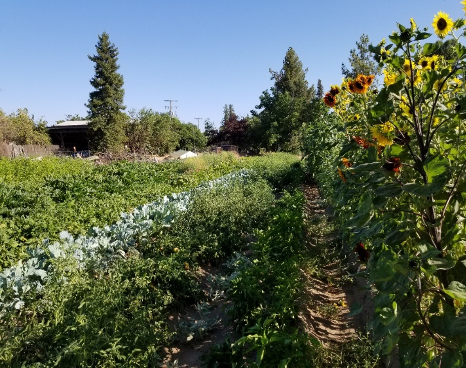- Author: Dana Yount
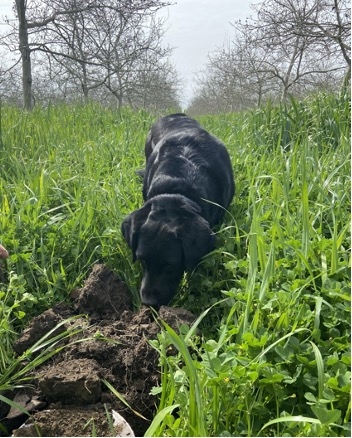
Daniel Unruh, and his family, farm just under 200 acres of walnuts alongside the Sacramento River, just outside of Princeton, CA. The walnut orchard is irrigated with solid set sprinklers and is only irrigated when needed, or if there is not enough rain during the season. Daniel started cover cropping in 2013 with the main goal of nematode suppression, and soon after, he and his wife took over the orchard operations. The cover crops that show up now between rows is voluntary, as he has not spread seed in years, but still sees a successful cover. He also practices reduced till on his farm to encourage the cover crop growth and help increase biomass production.
Daniel has not received money from any grants, or other outside funding sources to establish cover crops, this was just something he saw benefit in after the first few years of nematode reduction. His passion for cover cropping has grown to encompass more than just nematode suppression however, and he is now seeing plenty of benefits elsewhere around his orchard.
Beneficials of all kinds consider his orchard a home, less water is running off of his property during storms and irrigation, and he has cut his input and commercial fertilizer bill down by close to 75%. The soil organic matter for his orchard has also increased from around 1.7-1.9% to 3.0% when tested in 2020. When Daniel and his wife first took over in 2014, the orchard was sprayed for husk fly, coddling moth and blight, but now only blight has been addressed in recent years. In fact, he has not used any fertilizer at all the past few years, but has seen a slight reduction in yield as a result. Daniel also has seen changes in his irrigation cycle in what used to be a rotation of every 7-10 days, has been extended to every 12-14 days due to moisture retention.
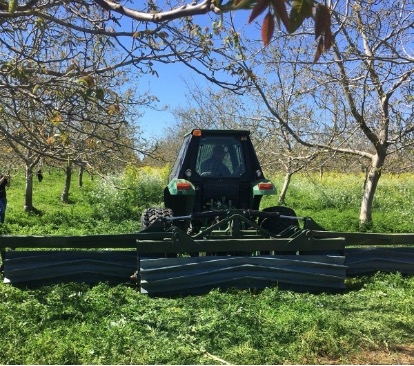
Like many other farmers, his main concerns with cover cropping in an orchard system was termination, and the learning curve that comes along with it. Daniel was even able to design a roller crimper, with chevron crimps, specifically for his operation and the type of cover crops he uses for termination. His cover crop stand consists of brassicas, grasses and legumes and can easily grow to over 6 feet tall. When he originally planted, Daniel spread seed 17 feet across for almost 90% coverage. His roller crimper helps lay plant material down to protect the soil from the sun, improve water retention and creates an environment beneficial to microorganisms.
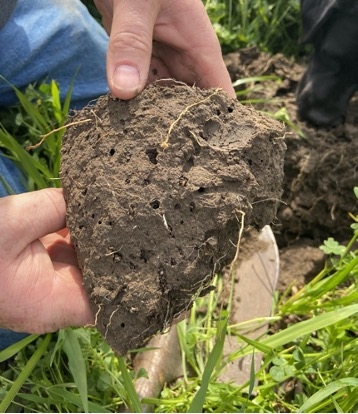
Daniel is so passionate about improving his soil microbiology and reducing his inputs, he even serves as a Mentor Farmer at the Chico State Center for Regenerative Agriculture. Daniel has presented at numerous events and has hosted workshops at his orchard to educate and encourage other growers to give soil management practices a try. Daniel says he is never done learning, and attends many workshops throughout the year as well.
Finally, Daniel encourages a holistic outlook, and motivates others to keep trying various approaches if it doesn't work the first time until you find a system that does work for your operation. He goes on to say you should try alternatives first before going straight to spraying fertilizer as eventually plants will rely on this synthetic ‘health' and it will not last.More on Daniel and how he has contributed to this research can be found at https://www.csuchico.edu/regenerativeagriculture/demos/daniel-unruh.shtml
- Author: Dana Yount
- Contributor: Kristian M Salgado
- Contributor: Emily Lovell
- Contributor: Caddie Bergren
- View More...
UC ANR Climate Smart Agriculture Educator team assisted growers to win CDFA grants that reduced greenhouse gases equivalent to removing roughly 7,000 cars off the road, supporting UC ANR's public value of building climate-resilient communities and ecosystems.
The Issue
Increasingly extreme and erratic weather patterns caused by climate change threaten crop yields and farm profits across the state. Growers must continue to adapt to climate stressors, such as increased temperatures and occurrences of drought, and can aid in reducing climate change through their farming practices.
How UC Delivers
A collaborative partnership between the Strategic Growth Council, California Department of Food and Agriculture (CDFA), and University of California Agriculture and Natural Resources (UC ANR) teamed up to support 10 Climate Smart Agriculture Community Education Specialists (CSA CES) throughout the state to provide technical assistance and outreach to promote Climate-Smart Agriculture Incentive Programs. These programs include:
- The Healthy Soils Program, which incentivizes the implementation of climate-smart agriculture practices such as cover cropping, composting, crop rotation, and mulching which reduce erosion and greenhouse gases
- The State Water Efficiency and Enhancement Program (SWEEP), which encourages farmers to install more efficient irrigation systems that decrease water consumption and greenhouse gas (GHG) emissions; and
- The Alternative Manure Management Program (AMMP), which awards funds to livestock producers who decrease their methane emissions by changing the way they manage manure.
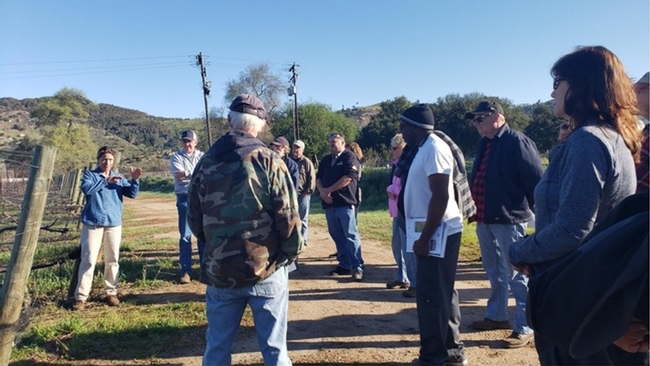
Since establishing this partnership in 2019, the UC ANR Climate Smart Agriculture Educator team has provided hands-on assistance to over 200 farmers and ranchers through the complex application process. Collaborating with other CDFA technical providers to host workshops, field days, and events has expanded reach to a greater number of growers, over 120 of whom were able to receive funding after receiving technical assistance. UC CSA CES efforts don't stop at the outreach or application phase; educators work year-round to ensure successful implementation of climate-smart projects.
After the award process, educators assist awardees in completing grant invoicing and contract reporting requirements and connect them with vendors, industry experts, and service providers. UC CSA CES also engage in a variety of additional support activities. For example, to help establish successful cover crop adoption, one educator created a cover crop decision-making tool. A different educator started a small compost spreader rental program to assist small growers in spreading compost. Another facilitates full project management through translation services to a cooperative of Cantonese-speaking awardees.
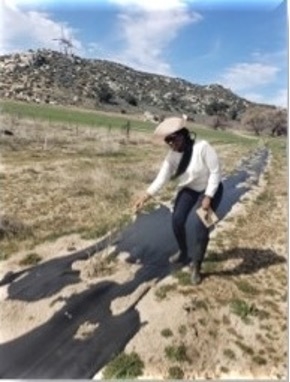
The Impact
Through assisting awardees in the adoption of practices such as cover cropping, installing solar panels, and installing dairy manure solid separator systems, the 10 UC CSA CES have collectively supported growers in reducing 33,000 MT/CO2 per year, as measured by California Air and Resources Board (CARB) Green House Gas Emission reduction calculator (SWEEP GHG Calculator on CDFA's website), and the HSP Comet planner tool. That's equivalent to removing 7,000 cars from the road per year.
Table A provides an overview of how much GHG has reduced in counties where the UC Climate Smart Agriculture Educator team has helped farmers implement climate-smart practices. Totals for all projects are much higher.
|
UCCE-County Location |
Total CO2 equivalent in MT/year |
|
Sonoma, Mendocino, and Lake County |
314.2 |
|
Merced, Madera, Stanislaus |
5263.31 |
|
Glenn, Butte, Colusa, Tehama County |
4545.785 |
|
Yolo, Solano, Sacramento, San Joaquin, El Dorado, Sonoma, Colusa, Sutter |
11716.4 |
|
Santa Clara County |
58.85 |
|
Fresno County |
1353.924 |
|
Kern & Tulare Counties |
7060.283 |
|
Santa Barbara, Los Angeles, Orange, Ventura County |
630.5 |
|
San Diego and Riverside Counties |
300.18 |
|
Imperial County and Riverside County |
3689.1 |

Glenn County grower, Shannon Douglass says, “When producers have the support from the UCCE office that they already know and trust, they are more willing to implement new practices. The application process is intimidating, but with the help from UC, soil healthy practices are becoming much more widely adopted.”
Research shows that Healthy Soils Program practices such as compost application increases the amount of organic matter in soil, amongst numerous other benefits such as increasing the water and nutrient retention capacity of soils, providing a reservoir of nutrients for plants, improving aeration, improving water infiltration, reducing soil erosion, and supporting the abundance and diversity of soil organisms, which can improve plant health. Compost application is just one fundable practice farmers can implement to help reduce greenhouse gases on their operation.
Thanks to this unique partnership with CDFA, UC ANR is able to provide hands-on support to farmers statewide so that they can improve the health of their soils, reduce livestock methane emissions, and improve water use efficiency. In this way, the Climate-Smart Agriculture program contributes to UC ANR's public value of building climate-resilient communities and ecosystems.
- Author: Shulamit Shroder
Practices: Occultation, cover crops, compost, field borders, reduced tillage, companion planting, crop rotation
Mary Jean Russell runs Pickalittle Farm, a diversified vegetable operation in Bakersfield, CA. She provides organically-grown vegetables and herbs to local restaurants and to CSA members. She started growing food in 2000, on the 3 acres of land surrounding her house.
She started implementing conservation practices in 2004 to save money and labor. The goal is to promote a healthy soil that produces nutritious food while minimizing costs and labor. To that end, she's developing a closed-loop system to reduce expensive external inputs. She's even found that weeds encourage beneficial insect populations. She calls her cocktail of cover crops, compost, and animal manure a bone broth for the soil, since it adds nutrients and organic matter to keep the soil healthy.
Last year, she expanded her operations to a 14 acre parcel on the edge of town. She currently farms on about 4 acres of the new property.
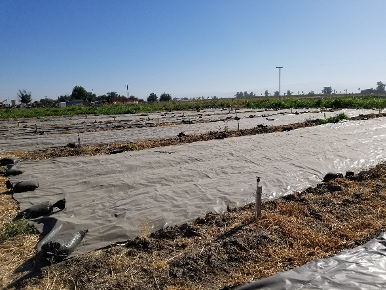
Practices
The first climate smart practice Mary Jean implemented on her farm was spreading compost. She then stopped spraying herbicides and insecticides and reduced her tillage. Then she started planting cover crops.
Mary Jean puts down tarps to reduce her weed population without resorting to herbicides or intensive tillage. This process is called occultation.
Black plastic covers the ground for a couple weeks and kills the growing weeds. She then takes the tarps off and irrigates the plot to encourage more weed growth. Once the new weeds have sprouted, she covers the area with the tarp again to kill off the nascent weeds.
This process worked well in the plots where she's already gone through the entire process and planted crops. The row of summer squash she planted enjoyed an almost weed-free plot – without any hand weeding, flaming, or tillage!
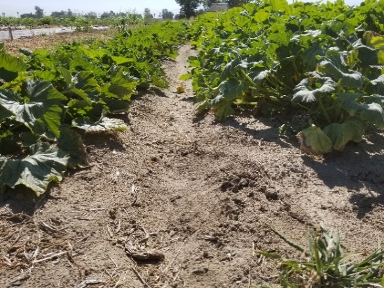
Effects
Yield effects
She started seeing increased yields at her first farm after about 1 year of compost applications and no sprays. The insects and soil started to balance out and she saw an increase in food quality.
Pest effects
Mary Jean has seen an increase in earthworms and other beneficial insects. The first year of not spraying insecticides at both her original farm and her new property saw huge swings in pest populations – a boom and bust cycle of pests like earwigs and flea beetles.
Erosion effects
She has found that dust devils that come onto the farm quickly die out because the weeds in the non-farmed areas, the cover crops, and the crops keep the soil covered. All these plants reduce the amount of dust that is available for the wind to pick up, so dust devils have to slow down and even stop when they get to her property.
Water consumption effects
She is working on reducing her water consumption and hopes that all the work that she is doing to increase the soil's organic matter will increase the soil's water holding capacity. Once her tomatoes start to fruit, she turns off the irrigation. This keeps the tomatoes from splitting and intensifies the flavors. She also has started planting cover crops like radish and sorghum to improve the soil's infiltration rates.
Effects on overall profitability
She does not buy sprays and does not have to apply for a pesticide applicator license. This saves her both money and time, since she doesn't have to deal with the paperwork or the continuing education credits she would need if she were farming conventionally. Plus she doesn't have to buy the specialized equipment for spraying insecticides or herbicides. Instead, she spends about $2,000 per half acre plot every 18 months to reduce her weed pressure by doing occultation and cover crops. This cost is less than what she would spend if she were farming conventionally.
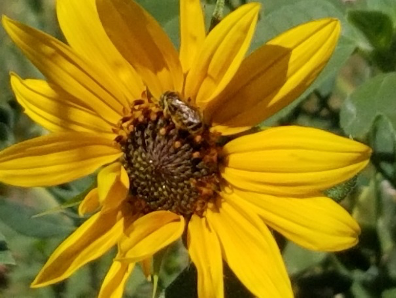
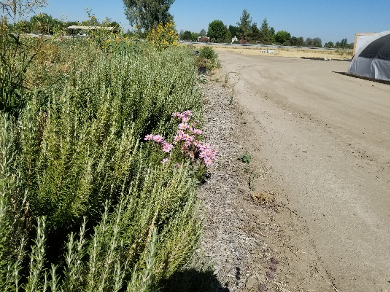
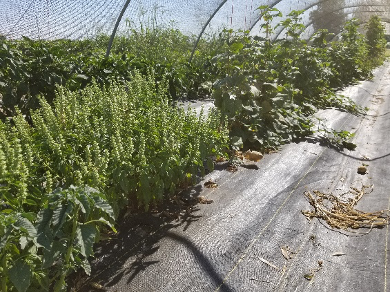
Recommendations
Mary Jean explained that there is a steep learning curve when implementing these practices. You have to understand the specific conditions of your field. Even the couple miles between the first garden and the new farm made a huge different in terms of pest and weed issues. At her new farm, Mary Jean learned the hard way not to put down any plastic tarps between November and April because the strong winter winds would destroy them.
She would recommend these practices to other growers, with some caveats. Plastic, after all, can pollute the soil and water and eventually ends up in the landfill. But for her, it's better than spraying synthetic chemicals and she hopes that another year or two of occultation work will knock down the weed pressure to the point that she won't have to use so much plastic in the future. She recommends that growers keep the occultation to a small scale.
For cover crops, she is still on the steep part of the learning curve, since there is so much to figure out: timing, termination, and species selection. She would recommend starting out with a dry-farmed winter cover crop.
She also advises growers to test their soil often and to create concrete, measurable short-term and long-term benchmarks and goals. She recommends reaching out to your local resources, including the extension office.
- Author: Shulamit Shroder
Practices: No-till, animal integration, alley cropping, poly cropping, composting, and cover cropping
Nathanael Siemens is an organic grower juggling a variety of crops, fields, and systems across California. He has a 150 acre farm in Modoc County and another 10 acres in Kern County. He is also working at the Rodale Institute's new farm research center in Ventura County.
He grew up on a farm in Kern County but left for college and only returned to farming 15 years ago. When he first got back into farming, he was doing management for other growers and didn't have the capacity to change up existing practices. Later on, he was hesitant to make big changes since the conventional system was already functioning.
This all changed during the recent drought, when it became clear to Nathanael that conventional farming was no longer viable. He started thinking outside the box by doing dry farming and implementing practices that build up organic matter. He also started planting multiple crops at once so that they don't all fail at the same time.
Practices
In Modoc, Nathanael dry farms grain crops. Dry farming is common in that area, but he also does no-till on this farm, which is less popular. He's also begun planting trees in the grain fields as part of an alley cropping system. He brings sheep onto the fields to graze after harvest.
In Buttonwillow, on the western side of Kern County,Nathanael grows grains, along with cotton and corn. He tried poly cropping, where he planted a wide variety of grains all together in one field. He reported that this was a fun practice, but he ended up only being able to sell about 5% of the product since the market for organic mixed grains hasn't materialized yet. He used the rest of the harvest for animal feed. He planted this mix of grains to reduce the likelihood of total crop failure. He tried doing reduced till in his cotton field here last year, but it didn't work out very well because of intense weed pressure. For this reason, he's scaling this experiment down to just 2 acres this year. The rest of the field is in corn. He hasn't transitioned to a no-till system for his corn yet, since this practice is more popular and thus less exciting to try out.
He implements a wide variety of conservation practices, but didn't start them all at the same time. The first practice he implemented was cover crops, 5 years ago. Then he started transitioning to no-till 4 years ago. He started planting poly crops 3 years ago, incorporated sheep into his systems 2 years ago, and started spreading compost one year ago.
Effects
Yield
Nathanael has seen an instant yield increase after implementing poly cropping. It has been harder to see the immediate effects on yield of compost and cover cropping.
He sells most of his grain at farmers' markets. This niche market supports farmers who have an interesting or compelling narrative. Farmers' market customers will pay a higher price for dry farmed crops.
Pests
Poly cropping/intercropping cotton has encouraged more biodiversity. In Buttonwillow, in Kern County, he has noticed a huge difference between his field and his neighbors' fields. There are more beneficial insects and birds in his field. Last year, his cotton suffered no insect damage.
Erosion
These practices, especially cover cropping and no till, have led to a noticeable decrease in wind erosion. This helps to improve the local air quality.
Water
In Modoc, Nathanael has seen a positive impact of these practices on his dry farmed grains. Wherever there is more mulch on the surface because of his no-till and poly cropping practices, he has noticed that there is more water in the soil. The crops therefore stay green longer.
Weeds
As already mentioned, the reduced till regimen for cotton didn't work out last year because the cotton was overwhelmed by weeds.
However, Nathanael has seen in his grain fields in Modoc that no till has reduced weed problems after the first year. The first year of no till there was difficult, but once the mulch layer gets established, it keeps weed seeds from germinating, especially the annual weeds that normally take over disturbed soils.
Profitability
Once Nathanael started bringing in sheep to graze his fields, he gained an extra income stream. This practice brings in additional revenue but only requires minimal additional inputs.
Overall, he said that these practices have helped the farm's bottom line. It's hard to determine the exact dollar amount because it has been a total lifestyle change. Instead of spending hours on a tractor, he's now spending that time talking to customers and managing animals.
Difficulties
Nathanael explained that there has been a steep learning curve in implementing these practices and that he is still on the steep part of that curve, especially for animal management. As he's found with his poly cropped grains, marketing his products has been a challenge. However, the farm has managed to find good opportunities to sell their niche products to people willing to pay for them.
Recommendations
He would recommend these practices to other growers. He would advise reaching out to consultants and other resources to learn from experts. Also, he learned that it is easier and more efficient to contract out instead of doing everything himself. This has been especially true with the sheep grazing, since he had not dealt with sheep before. He also pointed out that many regenerative practices aren't new, they're just not generally paired together like he's been doing.
He would advise trying a practice out on a few acres and seeing the results for yourself.
- Author: Shulamit Shroder
Steven Lee, PhD, has worked as the farm manager for Quaker Oaks Farm in Visalia, CA for the past 5 years. This 22-acre nonprofit educational center includes 8 acres of native wetlands, 2 acres of organic mixed vegetable crops, and 1 acre of organic stone fruit and Asian pears.
Steven has been working in agriculture for about 20 years, both in the lab and in the field. In 2017, he applied for the first round of Healthy Soils funding to implement a wide variety of conservation practices. The farm already did reduced tillage, but they used HSP funds to offset the costs of buying compost, planting cover crops, spreading mulch, and installing hedgerows.
He started these practices to improve the health of the soil and benefit the local ecosystem.
Practices
For the orchard, Steven has followed the following schedule:
In the spring, he mows down the cover crops and then applies compost. He spreads wood chips on top of the compost. The mulch has not yet caused a nitrogen deficiency in the fruit trees because it stays on top of the soil and is not thoroughly mixed in. In the fall, he disks the mulch in lightly and seeds the cover crops right before a rain. The cover crop mix he planted last year included triticale, vetch, bell beans, and field peas. However, he prefers planting oats over triticale.
In the vegetable cropping area, he follows a different procedure:
He drives up to Williams, CA in the fall to procure organic straw to maintain the farm's organic certification. He then spreads the straw mulch in the area between the vegetable beds. He found that rice straw was too clumpy to spread easily and thus prefers more traditional oat or wheat straw. He then seeds the cover crops into the mulch. The mulch improves cover crop seed germination, as it provides both moisture and protection from hungry birds. After disking in the cover crops in the spring, he plants his vegetable crops.
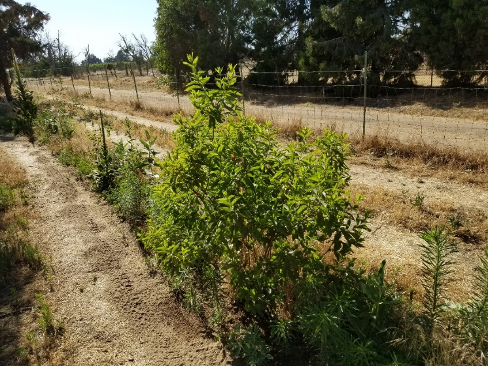
Effects
Soil
In just the past 3 years of doing these practices, the soil organic matter has increased from 1% to 2%. However, the soil pH has also gone up from 7 to 7.5. At some point, the increase in organic matter should help buffer and stabilize the soil.
Yield
The total yield has decreased because of the difficulty of incorporating cover crops into the vegetable system schedule. Cover crops and mulch require more work and effort to implement, and Steven and his team of volunteers couldn't get everything done in time. However, for him, the long-term ecological benefits are more important than a season or two of reduced yields.
Pests
The cover crops and hedgerows have led to increased insect diversity. There are more beneficial insects like ladybugs, green lacewings, assassin bugs, praying mantis, along with more pollinators like bees and hoverflies than there were a couple years ago.
However, there are also more ground squirrels, rabbits, and gophers. There are birds of prey and snakes, but not enough – the cover crops offer cover and protection for these pests.
Erosion
The mulch between the vegetable beds has reduced dust emissions, which makes working in the vegetable beds easier.
Water consumption
In both the trees and the vegetable crops, the mulch and compost keeps the soil moist. Steven has only watered the young fruit trees 3 times this year using furrow irrigation and has not seen any ill effects on tree health.
He has reduced his irrigation frequency on his vegetable crops from every other day to once a week. He estimates that he is now using about half the water he was applying before, but still has plenty of produce.
Overall profitability
Steven doesn't need to buy expensive organic blood meal anymore because the cover crops and compost provide enough nutrition. The long-term stabilization of soil productivity through the implementation of these practices should lead to resilience.
One of the difficulties he's had is that the timing for the Healthy Soils Program doesn't always match up with what makes the most sense for vegetable production. He had to skip a whole cycle to plant cover crops, which ended up costing the farm money.
Recommendations
He would recommend implementing these practices if they fit into your system. If you're interested in trying one of these practices, his advice is to keep it simple.
He is cautious about recommending straw mulch in vegetable crops, because he found it to be time-consuming and not cost effective. The biggest benefit for the straw mulch was that it improved cover crop germination. Spreading wood chips on the orchard floor was easier and so he would recommend that more than he would recommend the straw mulch.
His highest praise was for the hedgerows. He pointed out that you can plant herbs like rosemary, oregano, or sage, which would allow you to both sell a product and promote biodiversity.
Improvements
Looking back over the past 3 years, he would improve his implementation of these practices by simplifying and not overcommitting himself. He had better results when he seeded the cover crops between the vegetable beds instead of on the beds themselves.
He would also like to try further reducing tillage and using a roller crimper. This would turn the terminated cover crops into mulch. That way, he wouldn't need to import mulch from another farm.
He's also interested in doing multiple plantings of cover crops, now that the farm has finished its Healthy Soils project and thus will have more flexibility with its scheduling. For example, planting buckwheat, which grows so fast that it can evade drought and attracts beneficial insects.

